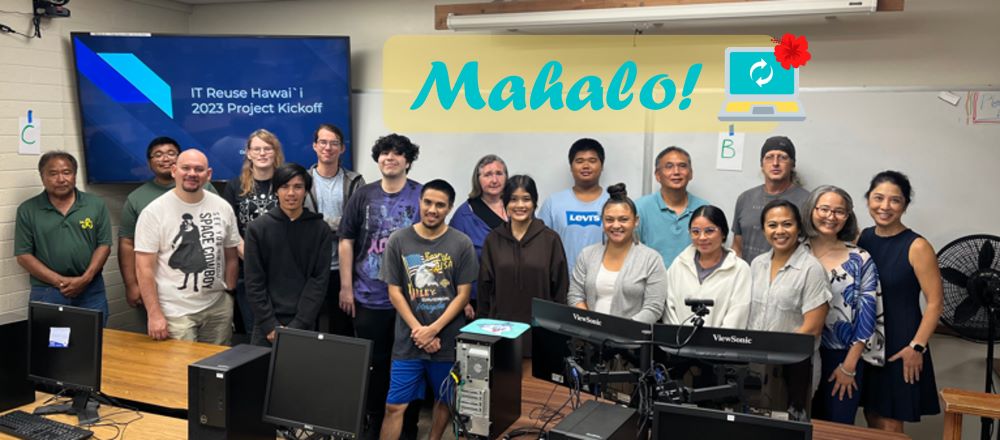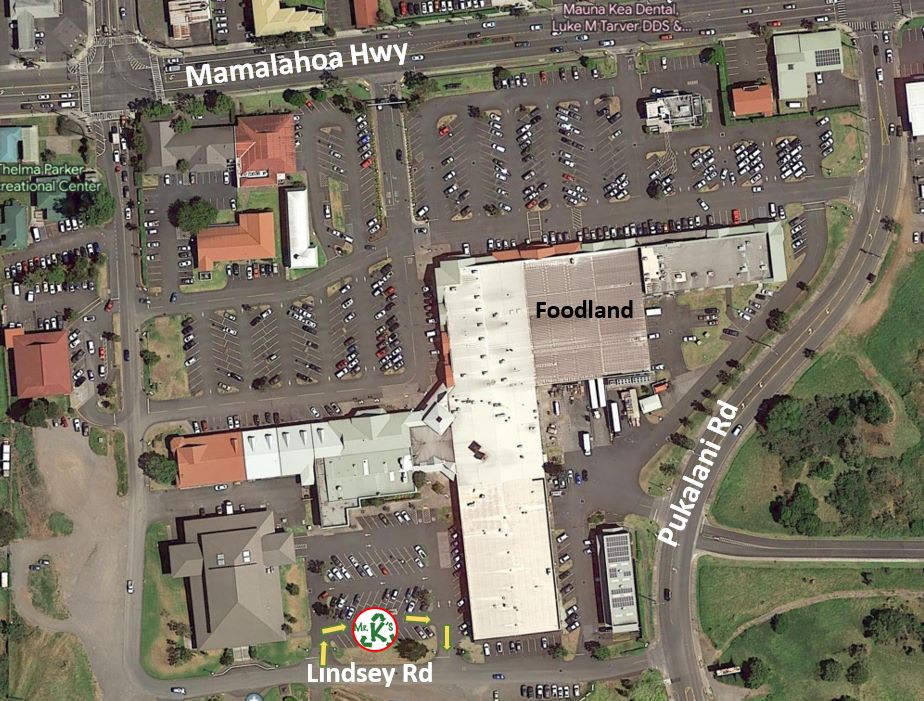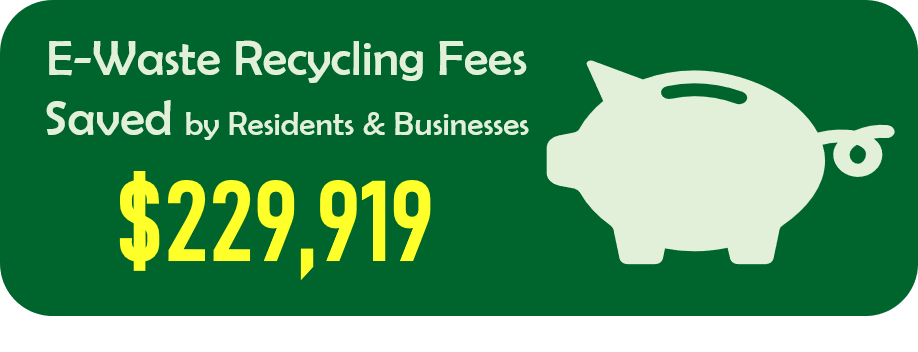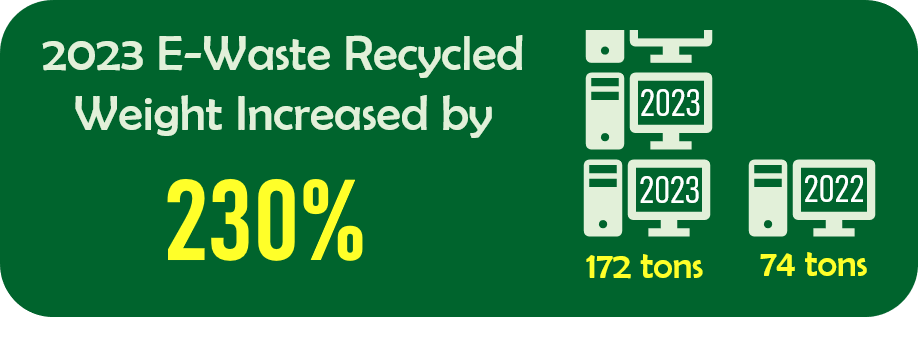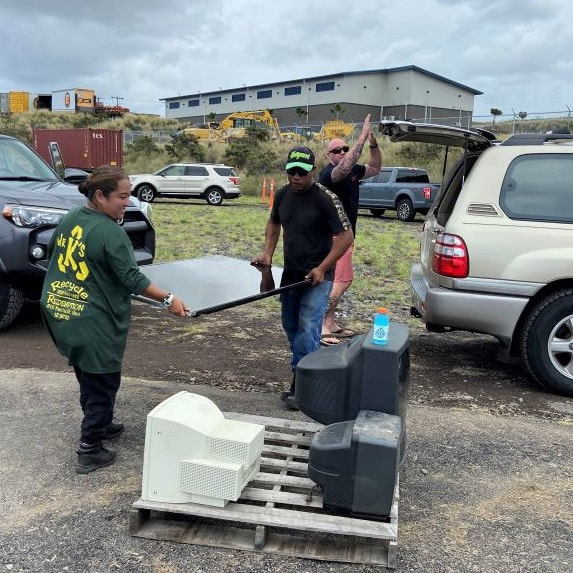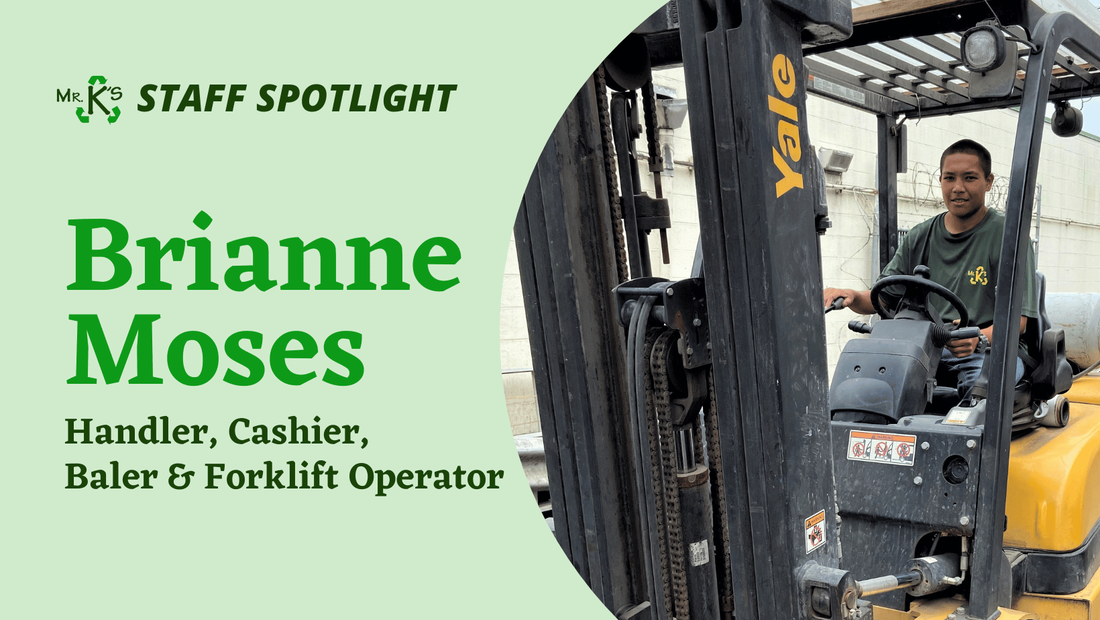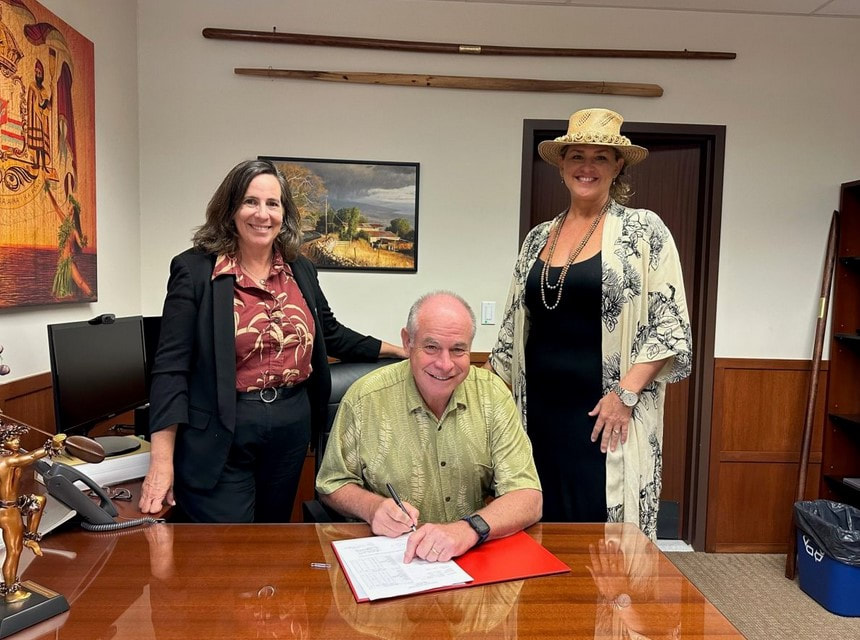Mr. K's Supports Refurbished Computers for Hawai`i Island Low-Income Individuals and Families10/26/2023 On October 5th, Mr. K's joined Hawai`i Community College (HCC) and Hawai`i First Federal Credit Union's Community Resource Center at the Fall 2023 Kickoff and Orientation of IT Reuse Hawai`i.
IT Reuse Hawai`i brings together HCC IT students to refurbish functioning computers donated by organizations and Mr. K's, to be distributed to low-income individuals and families to achieve their life goals through programs such as Hawai`i First's Pathways Financial Coaching and Financial Empowerment Services. IT Reuse Hawai`i also partners with PCs for People, based in Minneapolis, MN, to provide data sanitization and authorized installation of Windows OS and Office 2019. Mr. K's provides responsible, R2/e-Stewards-certified recycling of any devices or components that can't be reused. "Mr. K's made our initial pilot last year successful by donating functioning computers that were already wiped of data," said Michele Mitsumori, project coordinator for IT Reuse Hawai`i. "This not only extends the life of valuable assets, but also supports local individuals and families. We appreciate the partnership of Roy, Evan, Dale and the team at Mr. K's!"
2 Comments
(Graphic from p. 12 of the Hawai`i Digital Equity Plan) From the Hawai`i Broadband and Digital Equity Office:
With the draft of the Hawai`i Digital Equity Plan now complete, Hawai`i residents are invited to provide their mana`o (thoughts) on the plan and recommendations during a 30-day Public Comment Period, which runs from Oct 2 - 31, 2023. You can share your thoughts through this brief online form. "Digital equity" means that all Hawai`i's residents, keiki to kūpuna, have the information technology capacity -- devices, high-speed internet access, digital skills and technical support -- needed to participate fully in our society, democracy and economy, including civics, social and cultural activities, employment, lifelong learning, and access to essential services. The Digital Equity Plan was created to provide a roadmap for achieving digital equity for the nine "covered populations" which are:
How does this relate to Mr. K's? One way is ensuring that electronic devices and other equipment can be responsibly and accessibly disposed of, including through reuse and recycling. This can be done through Strategy 8, which prioritizes funding and investment policies such as recent e-waste legislation (Act 151), which provides Hawai`i with e-waste recycling at no cost. Mr. K's is holding a one-day Electronic Recycling Collection Event in Waimea:
Electronics such as TVs, computers (laptops & desktops), tablets, printers and cameras will be accepted. Here's the full list of what's accepted and not accepted for recycling. Businesses, government agencies and nonprofits need to schedule an appointment in advance. Contact Mr. K's. Mr. K's will pay for these items:
We're looking forward to holding a collection event in Waimea again after a long time! A Vision It started with divine inspiration. Lauren Blissett was struck by an urgency to find an alternative home for all the plastic bottle caps that end up in the landfill here on the Big Island. She had no idea what she was going to do with them, or why it had to be bottle caps. But the message was very clear: just do this. Her collection of bottle caps fit into a small bag, as her family doesn’t drink that many bottled beverages. But one day as she was driving past Mr. K’s Recycle & Redemption Center, the steering wheel seemed to turn by itself. Suddenly, there she was, surrounded by plastic bottles and caps. A regular customer who often brought her HI5's to Mr. K's, Lauren wasn't sure how to frame her request to instead take something away. “I was like, could I stand there with a separate trash can?” she recalled. The handler wasn’t sure, and referred her to Connie Bee, one of the office staff. Connie agreed, and Lauren’s collection of bottle caps began to grow. Caps Can Be Pretty Gross Several weeks or months might pass between when a beverage was consumed, when a customer brought their containers to Mr. K’s, and when Lauren picked them up from Connie. By the time she brought them to her aunt’s house in Puna, they were pretty gnarly. “I didn’t want to touch them with my hands,” she admitted. She devised a four-step cleaning process in her aunt’s garden, which involved soaking the caps in buckets of different concentrations of bleach, rinsing them with a high-powered hose, and then drying them out on a shower curtain and later a door screen laid over a pair of sawhorses. Each soaking lasted two to three days, and the whole process lasted two weeks. By the time one batch reached the final stage, Mr. K’s would call to say she could pick up another. “Connie would ask what I was doing with all these caps,” Lauren said, “and I would say it’s for an art project, but really, I had no idea.” Months passed and her pile of caps grew. From Landfill to Art In late July, Lauren and her son attended a workshop to make jellyfish out of plastic bottles at the Volcano Art Center (VAC) by visiting Māori artist and environmental activist George Tamihana Nuku. The exhibit featured beautiful sea creatures constructed out of single-use plastics and styrofoam. George and the VAC had planned a large-scale art installation engaging the community in creating art to “explore our changing oceans and changing identities due to the proliferation of single-use plastics in our modern world” (VAC). Titled Changing Oceans: Changing Minds, George had envisioned a symbolic map of Hawai`i Island surrounded by plastic marine life and sea birds, but hadn’t yet decided what the map would be constructed of. Then his and Lauren's paths crossed, and she was put in charge of creating a map of bottle caps. George and some other community volunteers bound together layers of donated styrofoam used in packaging and, together with another volunteer with degrees in art and geography, sculpted it into a relief map of the island. Then it was layered with plaster filler and a base coat, and Lauren painted it charcoal with white at the summits of Mauna Kea and Mauna Loa. Meanwhile, George was holding workshops with school groups, during which keiki sorted the bottle caps by color and pounded nails into them. Lauren Blissett paints the styrofoam relief map in an outdoor workspace at the Volcano Art Center. The lively color scheme of the map is laughingly described by Lauren as more “artistic” than literal, having been somewhat dictated by bottle cap availability. She had initially planned to do the map entirely in shades of green, but there weren’t enough caps. Big Island residents seem to drink a lot of Gatorade, as there were multitudes of orange caps, which together with some black caps, were used to suggest some lava flows, though not exactly. Blue caps depicted river placements, with an outline of blue to suggest the ocean, as well as to free up some needed green caps. The end creation is lively and familiar, while also encouraging viewers to discover their own associations. The island in process, with boxes of color-sorted caps with nails. Ending Single-Use Plastic by Changing How We See Its Value
Aside from the fun and creativity of the community project, Lauren was deeply inspired by George’s philosophy. “His perspective is that ultimately plastic is made using petroleum, which is very old and comes from deep inside the earth,” she explains, which gives it a sense of sacredness and divinity, almost like our kūpuna (elders). “The issue isn’t plastic itself, but the way we value it. We see plastic as disposable – just use it one time and throw it away. We don’t see all the possibilities of what you can do with plastic after you finish your drink,” Lauren said. “It’s the same with styrofoam.” “We must transform our relationship with plastic and the environment if we want to preserve our environment,” George explained. In an article exploring George's work, Karen Jacobs goes deeper into how George wants to end the single use of plastic by demonstrating the “divinity of plastic(s)” through using plastic in his creations. In addition to community engagement, George Tamihana Nuku, who is of Māori descent, has also created contemporary responses in plastic of historic Māori objects on display at the University of Cambridge. Visit the Volcano Art Center to see Lauren Blissett’s bottle cap map and experience Changing Oceans: Changing Minds by George Nuku. Hurry! The exhibition ends on September 10th, after which time it will find a more permanent home at the Keiki Science Museum in Kona. In August 2023, Mr. K's owner and manager, Roy Kadota, had a chance to see an exhibit called "The Art of Trash & Trashion Show" featured at Maui Mall. Organized by Mālama Maui Nui, the event is an annual, juried exhibition that inspires the Maui community to "reimagine discarded resources as elements for creative inspiration." Entries are original work by Maui artists using recycled and/or reused materials, and are judged by transformation of material, craftsmanship and overall creativity.
In the spirit of rethinking how we value things considered as "trash," Roy wanted to share some of these pictures. Enjoy! New E-Waste Law & Monthly West HI Collection Successful Hawai`i Island residents and organizations saved $229,919 in fees for the record 172 tons of electronic waste they've recycled over the first half of 2023. The savings is thanks to Act 151, which funds the program by manufacturers of electronic devices sold in the state. West Hawai`i residents made good use of twice monthly collection events in Kailua-Kona, where lead acid batteries, solar panels and newspaper are also collected. (map) Above: Mr. K's staffers unload a tv from a resident's car at a recent West Hawai`i collection event.
We can express our mālama ka ʻāina, caring for our land, by responsibly disposing of things we can no longer use. The lead acid battery in our cars typically expires in 3 - 5 years. From 2015 - 2019, an average of 202,013 vehicles were registered each year in Hawai`i County. If owners replaced their car battery every four years, that would mean over 50,500 batteries on average discarded every year. That's a lot of batteries! In the first half of 2023, Mr. K's collected 78 tons of lead acid batteries (about 3,900 units) from Big Island residents for responsible recycling. Why is this important? Three reasons:
To learn more: "Motor vehicle registrations, by county, 1995 - 2019," Section 18.07, 2020 State of Hawaii Data Book, Section 18 - Transportation. "Study claims lead batteries are most recycled consumer product in US," by Chris Voloschuk, RecyclingToday.com. "All the metals we mined in 2021: Visualized," by Govind Bhutada, VisualCapitalist.com.
Q: Hi, Brianne! Thanks for taking a few minutes away from operating the baler on a very hot day to talk with me. When did you first start at Mr. K's, and what made you interested in the job? Hi. It was in 2021. I was working in the kitchen at a restaurant, and I was tired of being inside. I wanted to be outside. I love being outside. Sometimes we [employees] complain about the heat and the rain, but outside, we can see everything. Gestures at the sky and all around. Q: What do you like most about working here? My co-workers. They are cool, nice and down-to-earth people who are easy to talk with and non-judgmental. Q: What's the hardest thing about working here? The heavy stuff. When the forklifts are being used somewhere and a big commercial load of electronic waste arrives, we have to drag and move it ourselves. Q: What's something you'd like our customers to know? It would really help if they could take the caps off their bottles and not have other rubbish in their bags. Before I worked here, I left the caps on, but thought, oh, it's their job to take them off. But then I started working here and it's so time consuming to have to take off all these caps, especially if we're really busy. Above: Brianne and the baler.
Claire Cea, office manager, shared how she values Brianne being part of the team up front as cashier. When customers happen to get upset about something, her understated demeanor and practical approach reassure them as they see her calmly taking next steps to resolve the issue. Brianne has also been a great help as a baler operator. "The baler is a big piece of equipment, and if it breaks, it can be down for a while," explained Claire. As baler operator, Brianne has demonstrated that not only can she operate the baler safely and responsibly, but also that she can work on her own, as the baler is in a rather isolated spot behind the building. Asked what advice she might give to others thinking about working in recycling and possibly operating machinery, Brianne laughs and says, "Don't be afraid to get dirty!" One more reason we're lucky we live Big Island! A new Office of Sustainability, Climate, Equity and Resilience will play a "pivotal role in shaping and implementing the county's response" to challenges posed by a changing environment.
Mayor Mitch Roth (above) signed Bill 48, creating the office on July 26th, flanked by County Council Members Heather Kimball (chair) and Rebecca Villegas, who championed the bill. (Photo courtesy of Hawai`i County) Read More Mr. K's donated a refurbished laptop to Michelle Kobayashi of Going Home Hawaii. Michelle wrote, "Blessings and appreciation to Roy, Aunty Constance, and their staff of Mr. K's Recycle! We got a laptop donated to us! Thank you Les and Kimi (Going Home Hawaii) for getting us hooked up and never giving up on me! You are all amazing!"
Pictured with Michelle are (L to R) Claire Cea, office manager, Roy Kadota, owner, and Connie Bee, office assistant. Going Home Hawaii assists justice-involved Hawai`i Island men, women and youth with reintegration into community life through employment, education, housing and appropriate services. Pictured with Michelle are (L to R) Claire Cea, office manager, Roy Kadota, owner, and Connie Bee, office assistant. |
Archives
October 2023
Categories
All
|

